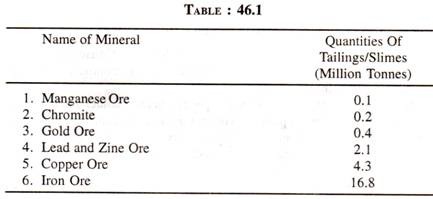Environmental Effects of Extraction Mineral Resources
Environmental costs of extracting mineral resources are explained in terms of land degradation, solid waste, air and water pollution, vibrations and health hazards.
(a) Land Degradation:
In Underdeveloped Countries, land degradation is from strip-mining of coal, the disposal of deep-coal mine tailing and acid mine drainage. Regional effects include acid precipitation, primarily from coal and oil combustion with its impact on soil, vegetation and lakes. Fine particles of toxic trace metals which accumulate in soil and in animal and human food chains are often dispersed during mining and refining operations.
(b) Solid Waste:
The mineral production is always associated with the solid waste generated in the form of overburden dumps, tailings and slimes. Areas around smelting and mining complexes are usually soiled by metals. Solid waste generated by mining production result in soil erosion, loss of fertile land and also soil pollution.
(с) Air Pollution:
An extraordinary wide range of environmental degradation is associated with fossil fuel combustion (sulphur dioxide and particulates), refinery operations (toxic emissions), coal combustion (dust and soot), industrial and automobile fuels (urban smog) etc. About 24 million tonnes of tailings/slimes were generated during 1997-98 from the concentrators and mineral treatment plants installed in copper, lead and zinc, gold, iron ore, chromite and manganese ore mines.
Table 46.1 shows mineral-wise quantities of tailings/slimes generated during 1999-2000 in India.
(d) Water Pollution:
Water pollution is a common feature of mining and associated mineral processing activities. Erosion of external overburden dumps during heavy rains is a major water pollution problem in mining areas. Abandoned mines and the disposal of chemicals used in refining are significant sources of water pollution in mining areas.
(e) Vibrations:
Explosives are used for fragmentation of rock masses in the mines by blasting. Ground vibrations and air-blasts not only cause nuisance to the residents of nearby areas but they may cause damage to the surface structures.
(f) Health Hazards:
Presence of dust particles in the atmosphere affect the human health in various ways. Workers suffer from lung and skin diseases. Further, they face breathing and vision problems. Improper use of minerals, for example, in asbestos—insulation, lead plumbing, lead and chromium- based paints can threaten human life.
Measures for Sustainable Mining and Minerals Development:
WSSD has suggested the following measures for sustainable mining and minerals development:
(i) To support efforts to address the environmental economic, social impacts and benefits of mining, minerals and metals through their life cycle, including workers’ health and safety.
(ii) To enhance the participation of stakeholders, including local communities and women, to play an active role in minerals, metals and mining development throughout the life cycles of mining operations.
(iii) To foster sustainable mining practices through the provision of financial, technical and capacity-building support to developing countries and countries with economies in transition for the mining and processing of minerals.
(iv) To solve the problems of displacement of the native people due to mining sites.


